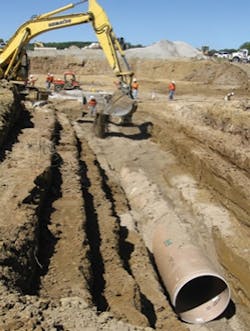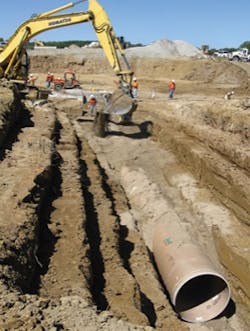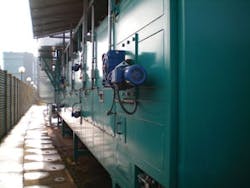Case Study: Power Plant Stirs Things Up to Clear Intake Station Pumps
For almost 50 years, CPS Energy of San Antonio has drawn water from the San Antonio River to recharge Braunig and Calaveras Lakes, which the utility built in the 1960s to provide cooling water for their power plants.
As is often the case with flat-water streams, the San Antonio River can experience high water events that churn the meandering channel into a raging torrent. These incidents have until recently left in their wake a thick buildup of silty muck on the intake structure's floor of the CPS pump station that draws from the river to recharge Calaveras Lake.
"A three- to four-foot deep buildup of sediment would cover the floors of the 36' x 20' x 50' intake's two pump chambers and block the suction bells of the 1500-HP vertical submersible pumps in each chamber which are 16 inches above the floor," according to Ron Christian with CPS Energy's Field Operations.
"The configuration of the trash grate and traveling screens only aggravated the buildup and the originally designed back flushing system lacked enough force to clear the mud from the pump suction bells. This became a chronic and critical problem, especially during summer months," he said.
Without the makeup water, the level of the shallow lake declined daily.
A four-man crew often spent several days clearing the mud from the pits. Most often, their tool of choice was a large compressor unit that would power an air lance to loosen the sediment while flushing it out of the diversion structure. It was a tedious task inevitably repeated after nearly every high water event.
The problem was finally resolved when CPS Energy learned how another Texas utility's ingenuity had rectified a similar problem. During a meeting with that utility, CPS learned how it had dealt with an almost identical problem at the raw water pump station serving their power station. They stopped the silt settling problem by installing Flygt submersible shrouded mixers, manufactured by ITT Water & Wastewater. The compact mixing units reliably stopped the sediment from settling and blocking the intake to the pumps.
CPS Energy's Jason Wauson and Will Warnke worked closely with an ITT Water and Wastewater representative and the manufacturer's applications engineers to determine the correct mixer selection and integration into the pumping station. This led to purchasing four, mast-mounted ITT Flygt Model 4640 mixers that were installed by a local contractor.
"During the installation, the pump station's intake was closed off and the pits drained and cleared prior to receiving the shrouded axial impeller units," Christian said. "Two were mounted on masts with cables in each pit about one foot above the floor on opposite sides of the intake pump suction bells. The mixers can have their delivery angle reoriented 180 degrees off the wall line and the units raised up and down using their cables. The utility's personnel installed new water level sensors and mixer controls for automatic start/stop operation whenever river levels are 401- to 403-ASL and the river pumps not in service.
"The intake chambers were flooded and stop logs removed," he said. "When the mixers were activated in the first pit early in 2008, even the small amount of sediment remaining on the floor was immediately churned up and flushed down river."
Following a series of high water events since, the Texas-scale problem caused by micron-size silt building up has been mitigated, saving man-hours once needed to clear the pits to help to insure a reliable source of makeup water from the river.
Mixer Selection
Selection of mixers for a water intake station (WIS) creates challenges even in the kind of mixer which can be used. Top entry type mixers are often difficult or even impossible to mount. Submersible mixers, because of their mounting flexibility, are often the only useable design.
Determining the size of mixer required for a WIS presents more challenges. A WIS is not a well defined tank or basin – one side is open to the river. Also, depending on the river's flow, deposition of material on the station's ramp can range from some fine silt to massive amounts of silt and sand.
The key in making the mixer selection is to recognize that a shear stress must be applied to re-suspend the accumulated solids. The magnitude of the total mixer thrust required to achieve this shear stress is a function of the area to be cleared, the consistency of the settled solids and the desired time to achieve the removal of the solids.


